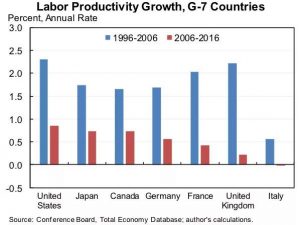In his column, “The Trade War’s Risks for Trump: Agriculture and manufacturing are significant industries in 2020’s most important states,” Louis Jacobson writes at Sabato’s Crystal Ball: “President Donald Trump has taken a hard line on trade. He’s imposed tariffs on steel, aluminum, and on a wide variety of Chinese products. In response, China has slapped tariffs on American products…If Trump’s trade strategy poses risks for the economy, it also poses risks for his reelection strategy. That’s because farmers and manufacturers in battleground states are facing retaliatory tariffs on their products…To measure Trump’s degree of risk, we analyzed 14 battleground states — 10 of them won by Trump in 2016 and four won by Hillary Clinton. (We ignored Nebraska’s competitive 2nd congressional district, and we looked only at Maine’s statewide electoral votes, not its competitive 2nd district. Both states allocate a portion of their electoral votes by congressional district.)…Trump won seven of them in 2016, making the core of his Electoral College majority at special risk from fallout from tariffs. Especially notable is the inclusion on this list of the three narrowly divided states that made his victory possible: Michigan, Pennsylvania, and Wisconsin…Depressed turnout among disaffected farm and factory voters might be more likely than actually switching rural and blue-collar Republicans to support whoever the Democratic nominee is…Craig Gilbert, a political journalist for the Milwaukee Journal Sentinel, has reported extensively from the swing rural areas of western and southwestern Wisconsin. He said he hasn’t encountered any sign of mass defections from the historically strong levels of Trump support in 2016, but he added that it remains an open question whether more modest shifts could occur…Bottom line: Trump’s trade policy could weaken his support in key states, but for now at least, there’s little evidence of widespread damage to Trump’s standing among the farm and factory demographics. Until further notice, cultural issues appear to be taking prominence over economic ones.”
Charlie Cook writes in The Cook Political Report that “In a tough Oct. 16 piece in The Atlantic, Ronald Brownstein cites a study by the center-left Urban Institute, which notes that a plan like those favored by Warren or Bernie Sanders “would require $34 trillion in additional federal spending over its first decade in operation. That’s more than the federal government’s total cost over the coming decade for Social Security, Medicare, and Medicaid combined, according to the most recent Congressional Budget Office projections.”…Brownstein goes on to point out: “In recent history, only during the height of World War II has the federal government tried to increase taxes, as a share of the economy, as fast as would be required to offset the cost of a single-payer plan.” Syracuse University professor and Clinton administration alumnus Leonard Burman adds that there are “no analogous peacetime tax increases.” Selling such a plan, he argues, “is theoretically possible,” but “the revolution that would come along with it would get in the way.”
“This is where the rubber meets to road in terms of electability,” Cook continues. “There is not any question that Warren is the most talented campaigner in the Democratic race today, and perhaps in Democratic politics altogether. She’s also put together a world-class campaign organization. But all of that may not be able to withstand the questions and attacks on some of her proposals. Apart from her health plan, there are real questions about whether her wealth tax would generate the $1.75 trillion in revenue over 10 years needed to fund her agenda—one that makes Franklin Roosevelt’s New Deal look somewhat modest…This is not to say that Warren can’t win the Democratic nomination. Today she would certainly be favored to win both the Iowa caucuses and the New Hampshire primary, but history shows that winning one or both is not tantamount to winning the nomination. Since 1972, every eventual Democratic nominee has come in first, second, or third in Iowa and either first or second in New Hampshire. The other co-front-runner, Joe Biden, could simply place or show in Iowa and place second in New Hampshire, biding his time until the primaries and caucuses move South and West—territory where polls show Biden does much better.”
Emily Stewart outs “The Wall Streeters who actually like Elizabeth Warren” at Vox: “On Wall Street, there are rich guys, and then there are very rich guys. And in the first camp, there are a surprising number who think an Elizabeth Warren presidency would not be the apocalypse…Some in the industry believe that the excesses of the financial system continue to be a problem in the wake of the Great Recession and that corporate concentration, wealth inequality, and lax regulation are still issues that need addressing. Do they think she’s 100 percent right on everything? No. But they know she’s smart, and they think she’s approaching policy with a scalpel, not a sledgehammer. They believe Warren when she says she is a capitalist and are on board with her brand of capitalism…“Even though, on a personal basis, Elizabeth Warren may be bad for me economically, she would be better for society, which I want my kids to grow up in,” a director at Citi told me…“I might not always agree with every move that she makes, but it would be hard to argue that she hasn’t done her homework on it,” said Charlie O’Donnell, a venture capitalist at Brooklyn Bridge Ventures…“Customers need protection. Corporations have so much at their disposal and an individual customer has nothing,” said a portfolio manager in the credit card division of a major bank.”
Stewart adds, “Supporters also trust her in the event of a potential recession. They see her as an experienced economic hand who would seek to spend more money at the lower ends of the economic spectrum rather than at the top, and they assume the deficit is going to continue to balloon whoever the next president is, Republican or Democrat. “At the macro level, the redistribution of wealth back into consumer’s pockets will positively impact equity markets,” said a State Street vice president. “It’s just what side of the ledger you want to look at.”…Warren may not be the most popular candidate on Wall Street, but she’s not the least popular one, either; it’s not as though the financial industry is immune to her rise in the polls. And her supporters acknowledge that while not everyone in their field will agree with them, they want them to give her a chance…They believe that if people sit down and actually look at her policies, they will see she’s not going to turn the United States into Venezuela. The big structural change she’s talking about, they think is a good thing. And presidents don’t get everything — or often most things — on their agendas done. They’re not scared, and they don’t think others in their position should be scared.”
Despite all of the favorable buzz about Warren, however, Jennfer Agiesta reports at CNN Politics that “Former Vice President Joe Biden’s lead in the race for the Democratic nomination for president has rebounded, and now stands at its widest margin since April, according to a new CNN poll conducted by SSRS…Biden has the support of 34% of Democratic and Democratic-leaning registered voters, his best showing in CNN polling since just after his campaign’s formal launch on April 25…Sens. Elizabeth Warren of Massachusetts and Bernie Sanders of Vermont are about even for second, with 19% and 16%, respectively. Behind them, South Bend, Indiana, Mayor Pete Buttigieg and Sen. Kamala Harris of California each have 6% support, with Sen. Amy Klobuchar of Minnesota and former Texas Congressman Beto O’Rourke each at 3%…Biden has seen big spikes in support among moderate and conservative Democrats (43% support him now, up from 29% in the September poll), racial and ethnic minorities (from 28% among all nonwhites in September to 42% now) and older voters (up 13 points since September among those 45 and older) that outpace those among younger potential Democratic voters (up 5 points among those younger than 45).”
Also at Sabato’s Crystal Ball, Seth Moskowitz has an interesting warning for Democrats in his post, “Up-Ballot Effects: Expanding the Electoral College Battleground: “A presidential campaign strategy narrowly focused on Pennsylvania, Wisconsin, and Michigan might work for the Electoral College but could hurt a candidate’s party in down-ballot Senate and House races…Senate and House battlegrounds are scattered across the Rust Belt and Sun Belt, which could incentivize presidential candidates to compete in states that they otherwise may have overlooked…Both presidential campaigns will have plenty of money, allowing them to invest in lower priority states with the dual purpose of trying to win longshot Electoral College votes and helping Senate and House candidates down-ballot…To help their respective parties down-ballot, presidential campaigns will need to appeal to a broad demographic of voters including white non-college voters in the Rust Belt and diverse, college-educated voters in the Sun Belt and suburban House districts across the country…The Republican and Democratic presidential nominees may not take these down-ballot incentives into account in their campaign strategies. But they do so at the risk of winning the presidency while failing to construct a governing majority. This prospect of a stalled legislative agenda, executive branch investigations, and unfilled court vacancies should drive the presidential campaigns to a down-ballot, party-centric strategy that expands the Electoral College battleground.”
Nathaniel Rakich notes at FiveThirtyEight, “Over the course of the entire 2016 presidential election, TV ad spending approached a whopping $761 million, with more than 920,000 spots flickering across the airwaves. But that might be nothing compared to what we see in 2020. Thanks to Tom Steyer, who is pouring an enormous amount of money into TV ad buys, we are already ahead of 2016’s pace…Using data from Kantar/Campaign Media Analysis Group, we can compare the pace of TV ad spending so far in 2019 with the same point in 2015. And so far, the 2020 campaign has seen more than twice as many television ad spots as the 2016 race. From January 1 through October 20, 2019, campaigns and outside groups spent an estimated $33.3 million on 76,030 television ad spots for the 2020 presidential election. By contrast, through the week of Oct. 18, 2015, campaigns and outside groups had aired only 32,191 TV spots — despite spending more money than they have so far this year ($43.1 million compared with $33.3 million).”
At Democracy – A Journal of Ideras, John Halpin and Brian Katulis illuminate a foreign policy approach that could win support for Democrats; “Donald Trump is the ultimate unilateralist, and not a particularly talented one. He undermines and demeans close allies. He pulls out of treaties and international accords designed to advance our own security and economic interests. He ignores global organizations like the United Nations and the World Trade Organization, and instead seeks ways to work around these institutions to pursue a constantly shifting set of foreign policy impulses. His top advisers operate under the same assumptions as Trump in pursuit of a “go it alone” approach that is getting increasingly dangerous and risky…During that time, the right has hammered Democrats for being soft on national security and bending to the will of the rest of the world. “America First” vs. “soulless globalism” remains the central frame of the Trump argument about the world. Progressives have been too timid in their own defense—crouched in a tactical posture, allowing Trump and his allies to set the terms of the foreign policy debate when it comes to multilateralism…This is exactly the wrong approach. Our recent research into American attitudes on foreign policy, building on our earlier opinion project from January to March 2019, and as outlined in the report entitled “America Adrift,” finds that majorities of voters want multilateralism…Plain and simple—Trump’s unilateralist approach is deeply unpopular outside of his core base. Democrats should lean into arguments about working with other countries and institutions in the world with no apologies.”










